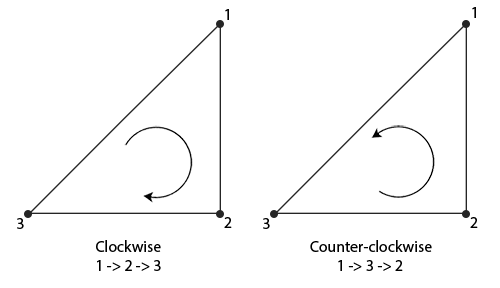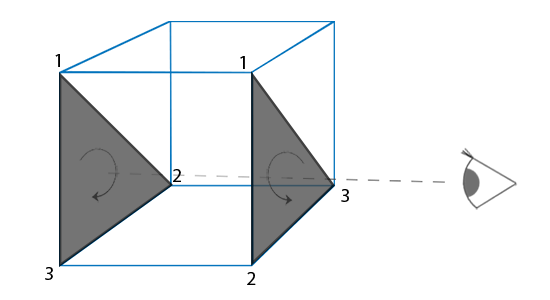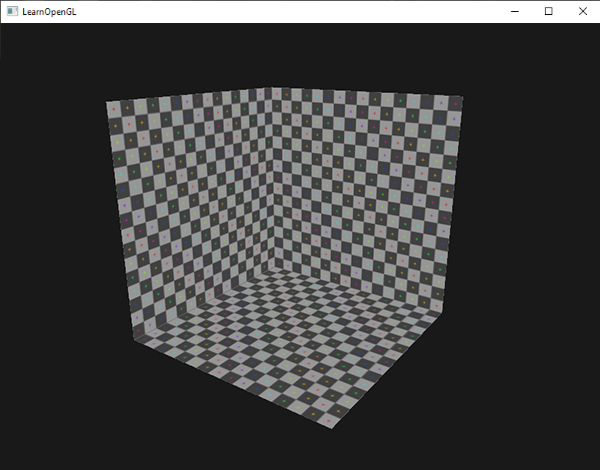Face culling
Advanced-OpenGL/Face-culling
Try mentally visualizing a 3D cube and count the maximum number of faces you'll be able to see from any direction. If your imagination is not too creative you probably ended up with a maximum number of 3. You can view a cube from any position and/or direction, but you would never be able to see more than 3 faces. So why would we waste the effort of drawing those other 3 faces that we can't even see. If we could discard those in some way we would save more than 50% of this cube's total fragment shader runs!
This is a really great idea, but there's one problem we need to solve: how do we know if a face of an object is not visible from the viewer's point of view? If we imagine any closed shape, each of its faces has two sides. Each side would either face the user or show its back to the user. What if we could only render the faces that are facing the viewer?
This is exactly what
Winding order
When we define a set of triangle vertices we're defining them in a certain winding order that is either

As you can see in the image we first define vertex 1 and from there we can choose whether the next vertex is 2 or 3. This choice defines the winding order of this triangle. The following code illustrates this:
float vertices[] = {
// clockwise
vertices[0], // vertex 1
vertices[1], // vertex 2
vertices[2], // vertex 3
// counter-clockwise
vertices[0], // vertex 1
vertices[2], // vertex 3
vertices[1] // vertex 2
};
Each set of 3 vertices that form a triangle primitive thus contain a winding order. OpenGL uses this information when rendering your primitives to determine if a triangle is a
When defining your vertex order you visualize the corresponding triangle as if it was facing you, so each triangle that you're specifying should be counter-clockwise as if you're directly facing that triangle. The cool thing about specifying all your vertices like this is that the actual winding order is calculated at the rasterization stage, so when the vertex shader has already run. The vertices are then seen as from the viewer's point of view.
All the triangle vertices that the viewer is then facing are indeed in the correct winding order as we specified them, but the vertices of the triangles at the other side of the cube are now rendered in such a way that their winding order becomes reversed. The result is that the triangles we're facing are seen as front-facing triangles and the triangles at the back are seen as back-facing triangles. The following image shows this effect:

In the vertex data we defined both triangles in counter-clockwise order (the front and back triangle as 1, 2, 3). However, from the viewer's direction the back triangle is rendered clockwise if we draw it in the order of 1, 2 and 3 from the viewer's current point of view. Even though we specified the back triangle in counter-clockwise order, it is now rendered in a clockwise order. This is exactly what we want to
Face culling
At the start of the chapter we said that OpenGL is able to discard triangle primitives if they're rendered as back-facing triangles. Now that we know how to set the winding order of the vertices we can start using OpenGL's
The cube vertex data we used in the previous chapters wasn't defined with the counter-clockwise winding order in mind, so I updated the vertex data to reflect a counter-clockwise winding order which you can copy from here. It's a good practice to try and visualize that these vertices are indeed all defined in a counter-clockwise order for each triangle.
To enable face culling we only have to enable OpenGL's GL_CULL_FACE option:
glEnable (GL_CULL_FACE);
From this point on, all the faces that are not front-faces are discarded (try flying inside the cube to see that all inner faces are indeed discarded). Currently we save over 50% of performance on rendering fragments if OpenGL decides to render the back faces first (otherwise depth testing would've discarded them already). Do note that this only really works with closed shapes like a cube. We do have to disable face culling again when we draw the grass leaves from the previous chapter, since their front and back face should be visible.
OpenGL allows us to change the type of face we want to cull as well. What if we want to cull front faces and not the back faces? We can define this behavior with
glCullFace (GL_FRONT);
The
- GL_BACK: Culls only the back faces.
- GL_FRONT: Culls only the front faces.
- GL_FRONT_AND_BACK: Culls both the front and back faces.
The initial value of
glFrontFace (GL_CCW);
The default value is GL_CCW that stands for counter-clockwise ordering with the other option being GL_CW which (obviously) stands for clockwise ordering.
As a simple test we could reverse the winding order by telling OpenGL that the front-faces are now determined by a clockwise ordering instead of a counter-clockwise ordering:
glEnable (GL_CULL_FACE);
glCullFace (GL_BACK);
glFrontFace (GL_CW);
The result is that only the back faces are rendered:

Note that you can create the same effect by culling front faces with the default counter-clockwise winding order:
glEnable (GL_CULL_FACE);
glCullFace (GL_FRONT);
As you can see, face culling is a great tool for increasing performance of your OpenGL applications with minimal effort; especially as all 3D applications export models with consistent winding orders (CCW by default). You do have to keep track of the objects that will actually benefit from face culling and which objects shouldn't be culled at all.
Exercises
- Can you re-define the vertex data by specifying each triangle in clockwise order and then render the scene with clockwise triangles set as the front faces: solution




